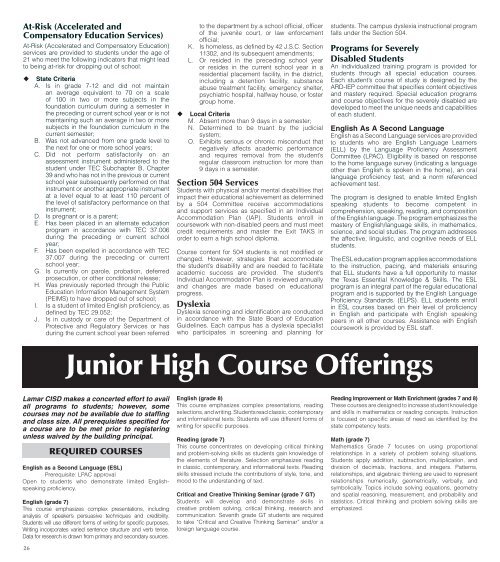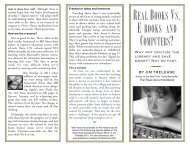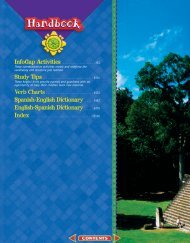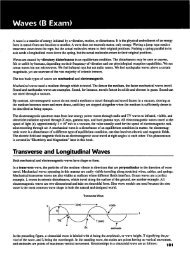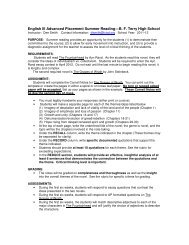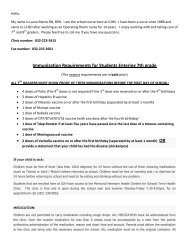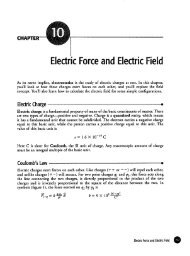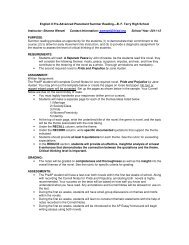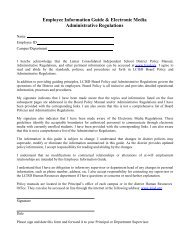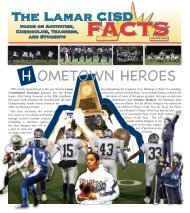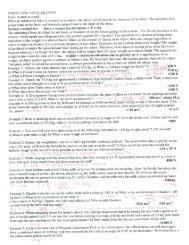Lamar CISD - District Information - Lamar Consolidated ISD
Lamar CISD - District Information - Lamar Consolidated ISD
Lamar CISD - District Information - Lamar Consolidated ISD
You also want an ePaper? Increase the reach of your titles
YUMPU automatically turns print PDFs into web optimized ePapers that Google loves.
At-Risk (Accelerated and<br />
Compensatory Education Services)<br />
At-Risk (Accelerated and Compensatory Education)<br />
services are provided to students under the age of<br />
21 who meet the following indicators that might lead<br />
to being at-risk for dropping out of school:<br />
u<br />
State Criteria<br />
A. Is in grade 7-12 and did not maintain<br />
an average equivalent to 70 on a scale<br />
of 100 in two or more subjects in the<br />
foundation curriculum during a semester in<br />
the preceding or current school year or is not<br />
maintaining such an average in two or more<br />
subjects in the foundation curriculum in the<br />
current semester;<br />
B. Was not advanced from one grade level to<br />
the next for one or more school years;<br />
C. Did not perform satisfactorily on an<br />
assessment instrument administered to the<br />
student under TEC Subchapter B, Chapter<br />
39 and who has not in the previous or current<br />
school year subsequently performed on that<br />
instrument or another appropriate instrument<br />
at a level equal to at least 110 percent of<br />
the level of satisfactory performance on that<br />
instrument;<br />
D. Is pregnant or is a parent;<br />
E. Has been placed in an alternate education<br />
program in accordance with TEC 37.006<br />
during the preceding or current school<br />
year;<br />
F. Has been expelled in accordance with TEC<br />
37.007 during the preceding or current<br />
school year;<br />
G. Is currently on parole, probation, deferred<br />
prosecution, or other conditional release;<br />
H. Was previously reported through the Public<br />
Education <strong>Information</strong> Management System<br />
(PEIMS) to have dropped out of school;<br />
I. Is a student of limited English proficiency, as<br />
defined by TEC 29.052;<br />
J. Is in custody or care of the Department of<br />
Protective and Regulatory Services or has<br />
during the current school year been referred<br />
u<br />
to the department by a school official, officer<br />
of the juvenile court, or law enforcement<br />
official;<br />
K. Is homeless, as defined by 42 J.S.C. Section<br />
11302, and its subsequent amendments;<br />
L. Or resided in the preceding school year<br />
or resides in the current school year in a<br />
residential placement facility, in the district,<br />
including a detention facility, substance<br />
abuse treatment facility, emergency shelter,<br />
psychiatric hospital, halfway house, or foster<br />
group home.<br />
Local Criteria<br />
M. Absent more than 9 days in a semester;<br />
N. Determined to be truant by the judicial<br />
system;<br />
O. Exhibits serious or chronic misconduct that<br />
negatively affects academic performance<br />
and requires removal from the student’s<br />
regular classroom instruction for more than<br />
9 days in a semester.<br />
Section 504 Services<br />
Students with physical and/or mental disabilities that<br />
impact their educational achievement as determined<br />
by a 504 Committee receive accommodations<br />
and support services as specified in an Individual<br />
Accommodation Plan (IAP). Students enroll in<br />
coursework with non-disabled peers and must meet<br />
credit requirements and master the Exit TAKS in<br />
order to earn a high school diploma.<br />
Course content for 504 students is not modified or<br />
changed. However, strategies that accommodate<br />
the student’s disability and are needed to facilitate<br />
academic success are provided. The student’s<br />
Individual Accommodation Plan is reviewed annually<br />
and changes are made based on educational<br />
progress.<br />
Dyslexia<br />
Dyslexia screening and identification are conducted<br />
in accordance with the State Board of Education<br />
Guidelines. Each campus has a dyslexia specialist<br />
who participates in screening and planning for<br />
students. The campus dyslexia instructional program<br />
falls under the Section 504.<br />
Programs for Severely<br />
Disabled Students<br />
An individualized training program is provided for<br />
students through all special education courses.<br />
Each student’s course of study is designed by the<br />
ARD-IEP committee that specifies content objectives<br />
and mastery required. Special education programs<br />
and course objectives for the severely disabled are<br />
developed to meet the unique needs and capabilities<br />
of each student.<br />
English As A Second Language<br />
English as a Second Language services are provided<br />
to students who are English Language Learners<br />
(ELL) by the Language Proficiency Assessment<br />
Committee (LPAC). Eligibility is based on response<br />
to the home language survey (indicating a language<br />
other than English is spoken in the home), an oral<br />
language proficiency test, and a norm referenced<br />
achievement test.<br />
The program is designed to enable limited English<br />
speaking students to become competent in<br />
comprehension, speaking, reading, and composition<br />
of the English language. The program emphasizes the<br />
mastery of English/language skills, in mathematics,<br />
science, and social studies. The program addresses<br />
the affective, linguistic, and cognitive needs of ELL<br />
students.<br />
The ESL education program applies accommodations<br />
to the instruction, pacing, and materials ensuring<br />
that ELL students have a full opportunity to master<br />
the Texas Essential Knowledge & Skills. The ESL<br />
program is an integral part of the regular educational<br />
program and is supported by the English Language<br />
Proficiency Standards. (ELPS). ELL students enroll<br />
in ESL courses based on their level of proficiency<br />
in English and participate with English speaking<br />
peers in all other courses. Assistance with English<br />
coursework is provided by ESL staff.<br />
Junior High Course Offerings<br />
<strong>Lamar</strong> <strong>C<strong>ISD</strong></strong> makes a concerted effort to avail<br />
all programs to students; however, some<br />
courses may not be available due to staffing<br />
and class size. All prerequisites specified for<br />
a course are to be met prior to registering<br />
unless waived by the building principal.<br />
26<br />
Required Courses<br />
English as a Second Language (ESL)<br />
Prerequisite: LPAC approval<br />
Open to students who demonstrate limited Englishspeaking<br />
proficiency.<br />
English (grade 7)<br />
This course emphasizes complex presentations, including<br />
analysis of speaker’s persuasive techniques and credibility.<br />
Students will use different forms of writing for specific purposes.<br />
Writing incorporates varied sentence structure and verb tense.<br />
Data for research is drawn from primary and secondary sources.<br />
English (grade 8)<br />
This course emphasizes complex presentations, reading<br />
selections, and writing. Students read classic, contemporary<br />
and informational texts. Students will use different forms of<br />
writing for specific purposes.<br />
Reading (grade 7)<br />
This course concentrates on developing critical thinking<br />
and problem-solving skills as students gain knowledge of<br />
the elements of literature. Selection emphasizes reading<br />
in classic, contemporary, and informational texts. Reading<br />
skills stressed include the contributions of style, tone, and<br />
mood to the understanding of text.<br />
Critical and Creative Thinking Seminar (grade 7 GT)<br />
Students will develop and demonstrate skills in<br />
creative problem solving, critical thinking, research and<br />
communication. Seventh grade GT students are required<br />
to take “Critical and Creative Thinking Seminar” and/or a<br />
foreign language course.<br />
Reading Improvement or Math Enrichment (grades 7 and 8)<br />
These courses are designed to increase student knowledge<br />
and skills in mathematics or reading concepts. Instruction<br />
is focused on specific areas of need as identified by the<br />
state competency tests.<br />
Math (grade 7)<br />
Mathematics Grade 7 focuses on using proportional<br />
relationships in a variety of problem solving situations.<br />
Students apply addition, subtraction, multiplication, and<br />
division of decimals, fractions, and integers. Patterns,<br />
relationships, and algebraic thinking are used to represent<br />
relationships numerically, geometrically, verbally, and<br />
symbolically. Topics include solving equations, geometry<br />
and spatial reasoning, measurement, and probability and<br />
statistics. Critical thinking and problem solving skills are<br />
emphasized.


